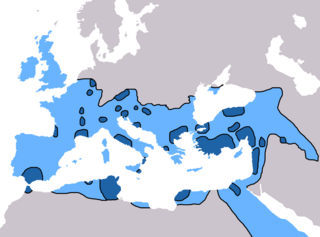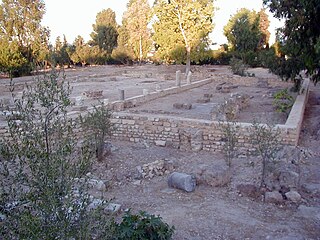Works
While at Constantinople, Primasius studied the exegesis of the Greeks, and his fame is chiefly due to his commentary on Revelation. This work, divided into five books, [3] is of importance both as a witness of the pre-Cyprian Latin text of the Book of Revelation used by the North African church, and as aiding in the reconstruction of the most influential Latin commentary on Revelation, the exegetical work of the Donatist Ticonius. The text and exegesis of Revelation 20:1-21:6 are taken without attribution from Augustine of Hippo's De civitate Dei , 20.7-17.
The work of Ticonius was considered by Primasius a piece of treasure adrift and belonging of right to the Church, needing only to be revised and expurgated. Ticonius had developed the theory introduced by Victorinus, to examine the different words and imagery used in different passages to convey the same message. Primasius followed this exegetical method very closely, but differed from Ticonius on the greater message of the text. Where Ticonius believed Revelation should be read in terms of the struggle of the Donatists with false brethren and gentiles, Primasius held the conflict properly lay between the Church and the world.
Of special interest is a letter of Augustine to the physician Maximus of Thenae preserved by Primasius, in which the four philosophical cardinal virtues are combined with the later three so-called theological virtues, making the number seven, in a manner nowhere else known of Augustine.
The first edition of Primasius's commentary was by Eucharius Cervicornus (Cologne, 1535; reprinted, Paris, 1544), but the most complete and still the most valuable is that of Basel, 1544, which is based on a very ancient manuscript of the Benedictine Monastery of Murbach in Upper Alsace. The same monastery, according to a manuscript catalogue, possessed a work Contra haereticos, which is no longer extant, and alludes to other works, especially one on Jeroboam. The commentary on the Pauline epistles and on Hebrews ascribed to Primasius by Migne is spurious. [4]
Autpert Ambrose (Ambroise) (Latin: Ambrosius Autpertus) (ca. 730 – 784) was a Frankish Benedictine monk. An abbot of San Vincenzo al Volturno in South Italy in the time of Desiderius, king of the Lombards, Autpert wrote a considerable number of works on the Bible and religious subjects generally. Among these are commentaries on the Apocalypse, on the Psalms, and on the Song of Songs; a life of the founders of the monastery of San Vincenzo (Latin: Vita Paldonis, Tasonis et Tatonis); and a Conflictus vitiorum et virtutum (Combat between the Virtues and the Vices). Jean Mabillon calls him "sanctissimus" because of his great virtue and the Bollandists gave him the title "saint". His cultus has been approved.

The Second Council of Constantinople is the fifth of the first seven ecumenical councils recognized by both the Eastern Orthodox Church and the Catholic Church. It is also recognized by the Old Catholics and others. Protestant opinions and recognition of it are varied. Some Protestants, such as Calvinists, recognize the first four councils, whereas Lutherans and most Anglo-Catholics accept all seven. Constantinople II was convoked by the Byzantine Emperor Justinian I under the presidency of Patriarch Eutychius of Constantinople. It was held from 5 May to 2 June 553. Participants were overwhelmingly Eastern bishops—only sixteen Western bishops were present, including nine from Illyricum and seven from Africa, but none from Italy—out of the 152 total.

Donatism was a Christian sect leading to a schism in the Church, in the region of the Church of Carthage, from the fourth to the sixth centuries. Donatists argued that Christian clergy must be faultless for their ministry to be effective and their prayers and sacraments to be valid. Donatism had its roots in the long-established Christian community of the Roman province Africa Proconsularis and Mauretania Tingitana, in the persecutions of Christians under Diocletian. Named after the Berber Christian bishop Donatus Magnus, Donatism flourished during the fourth and fifth centuries. Donatism mainly spread among the indigenous Berber population, and Donatists were able to blend Christianity with many of the Berber local customs.

Beatus of Liébana was a monk, theologian, and author of the Commentary on the Apocalypse, an influential compendium of previous authorities' views on the Apocalypse. He also led the opposition against a Spanish variant of Adoptionism, the heretical belief that Christ was the son of God by adoption, an idea first propounded in Spain by Elipandus, the bishop of Toledo.
Flavius Cresconius Corippus was a late Roman epic poet of the 6th century, who flourished under East Roman Emperors Justinian I and Justin II. His major works are the epic poem Iohannis and the panegyric In laudem Iustini minoris. Corippus was probably the last important Latin author of Late Antiquity.

Saint Victorinus of Pettau was an Early Christian ecclesiastical writer who flourished about 270, and who was martyred during the persecutions of Emperor Diocletian. A Bishop of Poetovio in Pannonia, Victorinus is also known as Victorinus Petavionensis or Poetovionensis. Victorinus composed commentaries on various texts within the Christians' Holy Scriptures.
Ticonius, also spelled Tyconius or Tychonius, was a major theologian of 4th-century North African Latin Christianity. He was a Donatist writer whose conception of the City of God influenced St. Augustine of Hippo.

Saint Optatus, sometimes anglicized as St. Optate, was Bishop of Milevis, in Numidia, in the fourth century, remembered for his writings against Donatism.
Possidius was a friend of Augustine of Hippo who wrote a reliable biography and an indiculus or list of his works. He was bishop of Calama in the Roman province of Numidia.
Fulgentius Ferrandus or Ferrand of Carthage was a Christian theologian of the Roman province of Africa, modern day Tunisia.
Julianus Pomerius was a Christian priest in fifth century Gaul. He wrote five treatises, only one of which, De Vita Contemplativa, survives. He was renowned in rhetoric and grammar and was friends with Ennodius and Ruricius. He appears to have fled from Mauritania, North Africa to Gaul to escape the Vandals, towards the end of the century. He became an abbot and a teacher of rhetoric at Arles, where he was known as the teacher of Caesarius, a great conservator of Augustine of Hippo's teachings. It is known that their titles probably emphasized the ascetic ideal.
Facundus of Hermiana was a 6th-century Christian author, and bishop of Hermiana in North Africa.

Commentary on the Apocalypse is a book written in the eighth century by the Spanish monk and theologian Beatus of Liébana (730–785) and copied and illustrated in manuscript in works called "Beati" during the 10th and 11th centuries AD. It is a commentary on the New Testament Apocalypse of John or Book of Revelation. It also refers to any manuscript copy of this work, especially any of the 27 illuminated copies that have survived. It is often referred to simply as the Beatus. The historical significance of the Commentary is made even more pronounced since it included a world map, which offers a rare insight into the geographical understanding of the post-Roman world. Well-known copies include the Morgan, the Saint-Sever, the Gerona, the Osma and the Madrid Beatus codices.
Verecundus was a 6th-century writer and the bishop of Iunca in Roman North Africa. He was an ardent champion of the Three Chapters.
Apringius of Beja was a sixth-century Latin Church Father who wrote a commentary on the Book of Revelation. Only fragments of his commentary survive.
Junillus Africanus was Quaestor of the Sacred Palace in the court of the Byzantine Emperor Justinian I. He is best known for his work on biblical exegesis, Instituta regularia divinae legis. According to M.L.W. Laistner, Junillus' work was based on the writings of one of the teachers of the School of Nisibis, Paul the Persian, and because Paul had been influenced by the writings of Theodore of Mopsuestia, Junillus' Instituta helped make Western theologians familiar with the Antiochene school of exegesis.

Christianity in the 4th century was dominated in its early stage by Constantine the Great and the First Council of Nicaea of 325, which was the beginning of the period of the First seven Ecumenical Councils (325–787), and in its late stage by the Edict of Thessalonica of 380, which made Nicene Christianity the state church of the Roman Empire.

The Archdiocese of Carthage, also known as the Church of Carthage, was a Latin Catholic diocese established in Carthage, Roman Empire, in the 2nd century. Agrippin was the first named bishop, around 230 AD. The temporal importance of the city of Carthage in the Roman Empire had previously been restored by Julius Caesar and Augustus. When Christianity became firmly established around the Roman province of Africa Proconsulare, Carthage became its natural ecclesiastical seat. Carthage subsequently exercised informal primacy as an archdiocese, being the most important center of Christianity in the whole of Roman Africa, corresponding to most of today's Mediterranean coast and inland of Northern Africa. As such, it enjoyed honorary title of patriarch as well as primate of Africa: Pope Leo I confirmed the primacy of the bishop of Carthage in 446: "Indeed, after the Roman Bishop, the leading Bishop and metropolitan for all Africa is the Bishop of Carthage."
Parmenian was a North African Donatist bishop, the successor of Donatus in the Donatist bishopric of Carthage. He wrote several works defending the rigorist views of the Donatists and is recognized as "the most famous Donatist writer of his day", but none of his writings have survived.
![]() This article incorporates text from a publication now in the public domain : Jackson, Samuel Macauley, ed. (1914). "Primasius". New Schaff–Herzog Encyclopedia of Religious Knowledge (third ed.). London and New York: Funk and Wagnalls.
This article incorporates text from a publication now in the public domain : Jackson, Samuel Macauley, ed. (1914). "Primasius". New Schaff–Herzog Encyclopedia of Religious Knowledge (third ed.). London and New York: Funk and Wagnalls.






